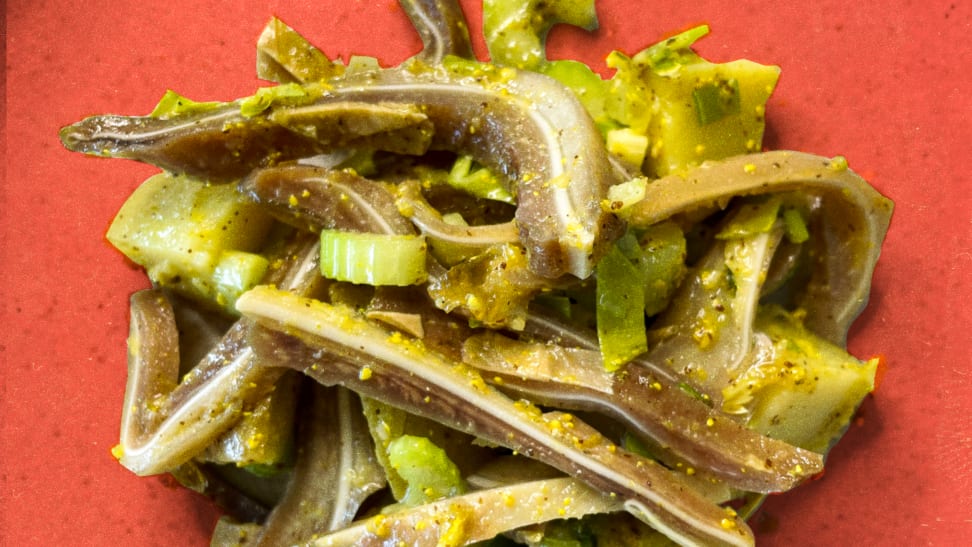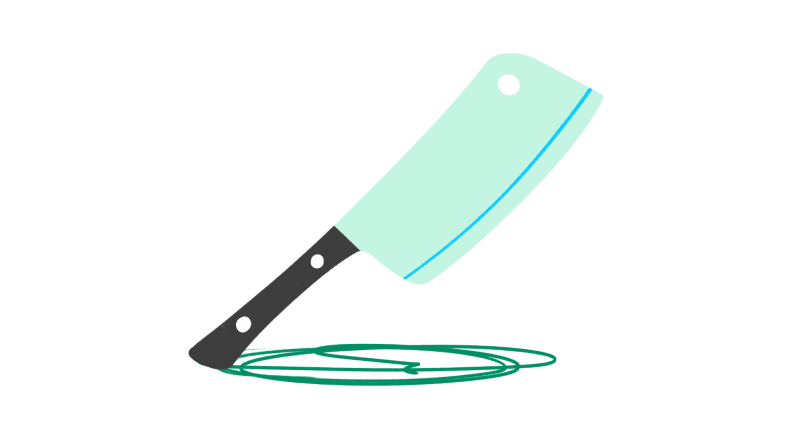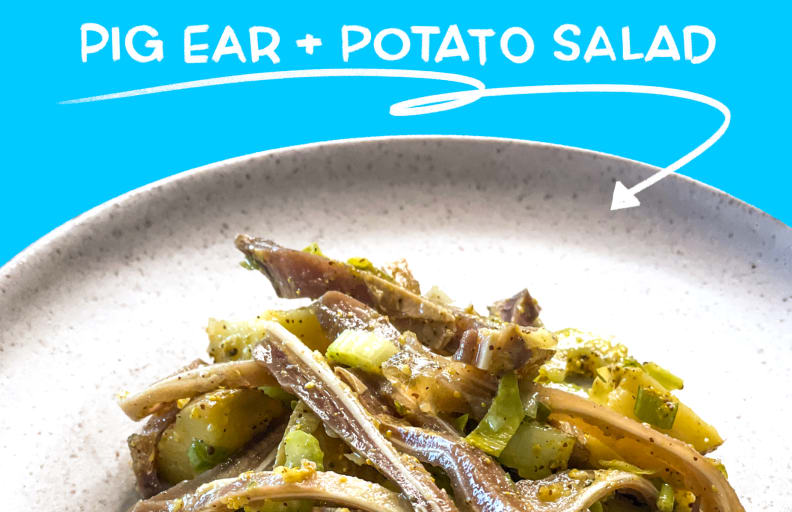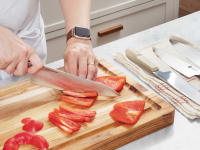 Credit:
Reviewed / Jenny Dorsey / Tara Jacoby
Credit:
Reviewed / Jenny Dorsey / Tara Jacoby
Recommendations are independently chosen by Reviewed's editors. Purchases made through the links below may earn us and our publishing partners a commission.
Jenny Dorsey is a professional chef, author and speaker specializing in interdisciplinary storytelling fusing food with social good. She leads a nonprofit named Studio ATAO and runs her own culinary consulting business. Her food and work has been featured in outlets such as Food Network, Oxygen TV, Eater, Food & Wine, Bon Appetit, among others.
Potato salad is one of the most classic side dishes (especially in the summer). In this version, I’ve also added in pig ears sliced with a cleaver for some crunch and protein. Pig ears are truly such a gem when it comes to pork cuts, and it’s a shame that it has yet to find mainstream traction. I’m hoping that pairing it with something as Americana as potato salad can encourage even more folks to incorporate “unusual” cuts into some of their existing staples.
This particular recipe was a happy accident in my kitchen. For the first iteration, which doesn’t taste anything like this version, I just so happened to have leftover pig ears from an earlier weeknight braise, and tons of extra Papa a la Huancaína I had made. Over time, I’ve completely changed out many of the original ingredients, it probably shouldn’t even be classified as a riff off a specific dish.
No matter which way you make it, a cleaver is key. To me, using a cleaver is both nostalgic and energizing. Its shape is far different from the western knives I was trained on, so when I’m reframing my shoulders and arms to use the cleaver, I always mentally envision my grandmother and how she would use the tool. So deftly, so softly–she made this large rectangular piece of metal look absolutely dainty. It’s a nice reminder of how much I still have to learn as I keep cooking, eating, and exploring.
Pro tip: Use your cleaver to cut through tough cartilage and bones, like chicken necks and feet. It’s much more effective than your carving knife in those instances, and will jolt your hands and forearms a little less—especially for petite chefs like me.
Cooking this dish? We want to see! Tag @reviewed and @brushlandeating on Instagram so we can share your masterpiece.
What you need

A cleaver is both effective and nostalgic for this chef.
Ingredients
For the pig ears: 2 tablespoons neutral oil 1 teaspoon whole cumin 1 teaspoon whole fennel seeds 1 small yellow onion, peeled, sliced 3 cloves garlic, peeled, sliced 2 stalks celery, chopped ¼ cup Shaoxing wine 3 pig ears 1 tablespoon kosher salt ½ teaspoon white sugar 1 quart unsalted chicken, pork, or vegetable stock
For the salad: 1 pound small yellow or red potatoes, boiled until fork-tender, quartered Sliced pig ears, from above 3 stalks celery, thinly sliced 4 stalks scallion, stemmed, minced 3 cloves garlic, peeled, grated ¼ cup dill, chopped 3 tablespoons whole grain mustard, plus more to taste 2 tablespoons rice vinegar, plus more to taste 1 tablespoons toasted sesame oil, plus more to taste Kosher salt, to taste White sugar, to taste
Tools
Cleaver Pressure cooker or large pot Spatula Knife Cutting board Tongs
Time Needed
1 hour, 45 minutes
Difficulty
Medium
Yield
Approximately 2 quarts
How to make Pig Ears and Potato Salad

This recipe adds a twist to the classic side.
Step 1: Saute aromatics in pressure cooker
In a pressure cooker or a large pot, heat neutral oil over medium heat until slick and shiny. Add cumin and fennel seeds, and saute 1 minute or until fragrant. Add onion, garlic, celery with a dash of salt and saute 3-5 minutes until onions are translucent. Increase heat to high, and deglaze with Shaoxing wine.
Step 2: Boil pig ears (optional)
Optional step: Bring a separate large pot of water to a rolling boil. Add whole pig ears and boil for 1 minute. Drain and rinse.
Step 3: Add pig ears to pressure cooker
Add pig ears, kosher salt, sugar, and stock. Mix to combine thoroughly.
Step 4: Cook pig ears
If using a pressure cooker, set to high pressure for 1 hour, with natural pressure release. Once released, continue cooking pig ears in stock in the pressure cooker until the stock has reduced considerably, to approximately 1 cup.
If using a large pot, bring to a simmer, then let braise about 2 hours, covered, or until pig ears are soft and pliable, but still crunchy at the center. Add water or stock as necessary to keep the pig ears submerged throughout the cooking process.
Step 5: Slice pig ears
Remove pig ears from the pressure cooker or pot, and discard any aromatics. Let cool, then use a cleaver to slice into thin strips, approximately ¼-inch in width.
Step 6: Assemble the salad
Combine all salad ingredients in a mixing bowl and mix thoroughly. Serve chilled.
This recipe is part of our Chef's Course newsletter series. Sign up to be the first to receive tips, tricks, and delicious recipes from top chefs sent straight to your inbox. It’s a whole master course for free.
The product experts at Reviewed have all your shopping needs covered. Follow Reviewed on Facebook, Twitter, Instagram, TikTok, or Flipboard for the latest deals, product reviews, and more.
Prices were accurate at the time this article was published but may change over time.



